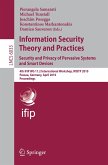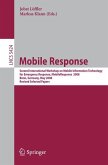The perspective of a society with pervasive computing features is becoming a reality and is made possible by intelligent devices of the size of a grain of sand: tiny devices, with many different degree of miniaturization, power autonomy, communication capabilities, applications and last but not least costs. Such devices are resource constrained in memory storage, in computation power and in energy. Despite the appealing feature and the myriad of possible applications, the resource constrained nature of such devices, the wireless environment in which they operate, the broadcast way to communicate and their unattended use, expose them to many known threats, while traditional countermeasures cannot be adopted in the above mentioned technologies: RFID tags and sensor nodes cannot use asymmetric cryptography, tamper-proof solutions would increase the costs of such technologies, and so on. This book describes several protocols specifically designed to be employed in resource constrained devices, that try to hit the right balance between security objectives and security overheads.
Bitte wählen Sie Ihr Anliegen aus.
Rechnungen
Retourenschein anfordern
Bestellstatus
Storno








